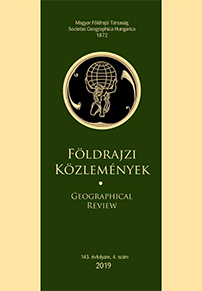Data for the Landscape History of the Two Török-Halom Kurgans in Kétegyháza (Hungary)
Abstract
Only a few ancient architectural monuments remain standing in the central region of the Hungarian Great Plain. However, the kurgans’ unique 5000-year-old treasures still exist in this area, with many landscape archaeological, archaeological topography, and landscape ecological survey prospects. Mounds can be found on the banks of no-longer exisiting rivers and at some points of higher altitude areas. The oral tradition of the Great Hungarian Plain marked the man-made, artificial, conical rises in the landscape that are associated with ancient, archaeological periods as mounds. According to their origin, kurgans can be classified as burial sites and sacred points of nomad people in prehistory. The two „Török-halom” kurgans are the biggest burial mounds of the kurgan field near Kétegyháza (Békés County, Hungary) in the Körös-Maros National Park (Kígyósi-puszta). Built by people of the Yamnaya Entity in the Late Copper Age (3000–2700 BC), the northern kurgan and its surface is intact without drastic disturbance, and in the vicinity there are natural sites, especially saline grasslands. Our research team worked on landscape archaeological, landscape historical, and GIS informatical investigations. We made a 3D field model of the kurgan, and created the landscape history and local changes of the last 300 years based on boundary charters, handmade and printed maps, archive, air and orto photos. Due to the botanical survey we made a complete list of the vascular plant species found on the surface of the original northern kurgan. The flora of the earth monument is species-rich. Most species have a generalist loess grassland or ruderal character, though there also occur some valuable species of botanical and nature conservation importance (e.g. Ranunculus illyricus, Rosa rubiginosa, Ononis spinosiformis subsp. semihircina, Stachys germanica, Carthamus lanatus). The southern Török-halom kurgan was mined by the local agricultural cooperative in 1967. Before the full mining of the site an archaeological excavation was carried out on the kurgan, during which the central burial site and three other burials were documented. After the mining only a little part of the bottom remained on the north-west side, which conserved original loess vegetation. In a large-scale project the southern kurgan was rebuilt by the Körös-Maros National Park Directorate in 2011, and its surface has reconstructed loess vegetation. Since no settlements of the nomadic Late Copper Age/Early Bronze Age Yamnaya communities have been discovered yet in the Carpathian Basin, the only way to collect more information on these people is through the analysis of their special graves, the burial mounds.
Copyright (c) 2020 Bede Ádám, Péter Czukor, András István Csathó, Pál Sümegi

This work is licensed under a Creative Commons Attribution-NonCommercial-NoDerivatives 4.0 International License.



